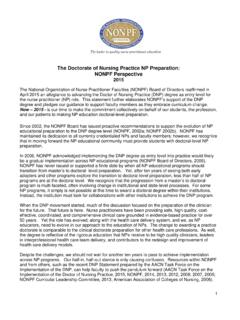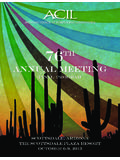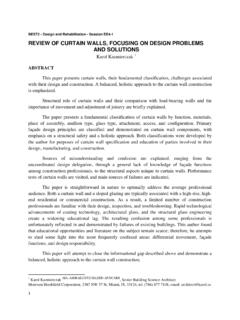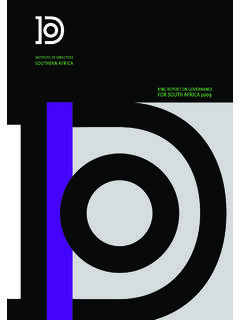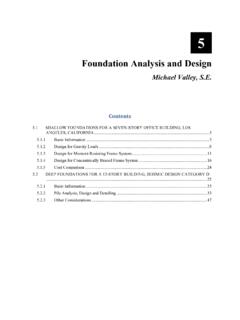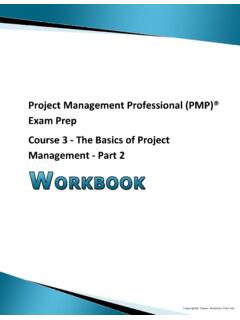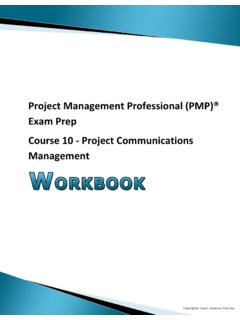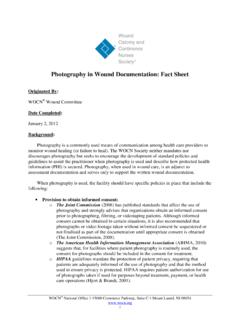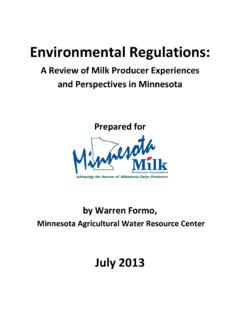Transcription of Common Coating Inspection Practices, Standards & …
1 Common Coating Inspection practices , Standards &. Equipment Presented By: Joseph Saleeby 10 Year, Principal Technical Representative Independent Representative of Tnemec Company, Inc. NACE Level 3 Certified Coating Inspector #13069. Presentation Summary: Basics of Coating Inspection . Coating Specification. Brief Introduction to Surface Preparation Standards . Commonly used Standards and Inspection Equipment. Types of Inspectors Third party inspector supplied by an independent consulting firm (full or part time). A corrosion engineer or someone assigned by the owner or architect. A retired painter or Coating supervisor. The contractor. Should have some type of nationally recognized certification. Basic Inspection Practice Preliminary Inspection Responsibilities Inspection of Surface Preparation Inspection of Coating Application Post-Application Inspection Preliminary Inspection Responsibilities 1.
2 Read and understand the job specification 2. Attend the pre-job conference 3. Become aware of safety hazards and responsibilities 4. Prepare Inspection forms and Inspection plan 5. Inspection of jobsite conditions 6. Inspection of materials 7. Inspection of equipment 8. Monitor ambient conditions What do you do when you don't have a 3rd Party Inspector? Manufacturer's can design very impressive technology but when it is improperly specified or installed incorrectly the technology is useless.. Common Sense Team Building Specification Elements of a Typical Coating Specification General Sampling coatings Terms and definitions Workmanship Reference Standards and Application codes Work schedule Scope Repairs and remedial Safety Coating work Prejob conference Inspection Surface preparation Documentation Coating materials Keys to Success . Put together a team building document for the specific project.
3 Require a qualified and experienced industrial coatings & lining installer. Require a knowledgeable NACE Certified Manufacturers Rep to review existing Coating conditions prior to beginning the project. Keys to Success . Require a pre-paint meeting where the owner, applicator and selected manufacturers NACE Certified Representative and inspector if employed all meet on site prior to Coating application. This meeting will insure that everyone is clear on the schedule, surface preparation and application methods. Require holdpoint-inspections. The NACE Certified Manufacturer's Representative will visit the site weekly or as needed to support the application of the products and report any deficiencies to the team including the owner/engineer in writing. Keys to Success . Require the performance you believe in. Require specific generic type base on the performance of the manufacturer most involved with the project or most qualified for the application.
4 Polyamidoamine Epoxy, Fluoropolymer, etc. Require necessary performance characteristics. , adhesion, corrosion resistance, H2S Resistance, permeability, abrasion resistance, UV resistance, cyclic salt fog, immersion, etc. When in doubt . Contact your trusted knowledgeable Coating consultant/manufacturers representative. If over- Coating , require test patch to verify adhesion. Have the Coating consultant review the project and put together a written Coating recommendation. Utilize qualified installers for the recommended products. If you have a new project in design have your manufacturer's representative meet with the design firm to discuss the parameters of the application. Visual Standards &. Observations SSPC-Vis 1 Visual Standard SSPC-SP13/NACE 6. Surface Preparation of Concrete Prep of concrete by mechanical, chemical, or thermal methods Applicable to CIP, Pre-Cast, CMU, & Shotcrete Free of laitance, loose adhering concrete & dust Use ICRI CSP visual Standards Technical Guidline No.
5 03732. Quality Control Visual & Dry Mils Quality Control How you ensure you are getting what you specify. Verify adhesion & compatibility of coatings. , Evaluation/Report/Testing /Test Patch Verify Surface Preparation Verify wet or dry film thickness Verify surface and ambient conditions Holiday Testing Thorough visual Inspection All performed by the project team Documented Findings (Daily Logs). Quality Control When you fail to plan, you plan to fail! Surface Preparation Contaminants Oil, grease, soil Dirt/dust Mildew Various chemical Soluble salts(non-visible). Rust Loose or broken mill scale Rust scale Loose Mill Scale Factors of Surface Preparation Anchor pattern Blast profile Prep cleanliness Sharp ridges, burs, edges or cuts Surface condensation Old coatings with poor adhesion Surface Preparation Standards Industry accepted SP Standards : SSPC: The Society for Protective Coatings (SSPC).
6 NACE International (NACE). International Concrete Repair Institute (ICRI). Standards in WTP & WWTP. Steel Surfaces: SSPC-SP1 Solvent Cleaning SSPC-SP2 Hand Tool Cleaning SSPC-SP3 Power Tool Cleaning SSPC-SP11 Power Tool Cleaning to Bare Metal SSPC-SP5/NACE 1 White Metal Blast SSPC-SP10/NACE 2 Near White Metal Blast SSPC-SP6/NACE 3 Commercial Blast SSPC-SP7/NACE 4 Brush-Off Blast SSPC-SP12/NACE 5 Surface Preparation and Cleaning of Metals by Waterjetting Prior to Recoating SSPC-SP13/NACE No. 6 Surface Preparation of Concrete Rust Grades of Steel Grade A Grade B. Grade C Grade D. SSPC-SP5/NACE 1. White Metal Blast Cleaning Abrasive Blast cleaning of steel surfaces Free of all oil, grease, dust, dirt, mill scale, rust, Coating , oxides, corrosion products, foreign matter, & stains Removes all existing Coating , mill scale, rust, oxides, corrosion products, stains, &.
7 Other foreign matter SSPC-SP10/NACE 2. Near White Metal Blast Cleaning Abrasive Blast cleaning of steel surfaces Free of all oil, grease, dust, dirt, mill scale, rust, Coating , oxides, corrosion products, foreign matter Random staining up to 5%. from rust, mill scale or previously applied coatings SSPC-SP6/NACE 3. Commercial Blast Cleaning Abrasive Blast cleaning of steel surfaces Free of all oil, grease, dust, dirt, mill scale, rust, Coating , oxides, corrosion products, foreign matter Random staining up to 33% from rust, mill scale or previously applied coatings SSPC-SP7/NACE 4. Brush-Off Blast Cleaning Abrasive Blast cleaning of steel surfaces Free of all oil, grease, dust, dirt, & loose mill scale, loose rust, & loose Coating Mill scale, rust ,and Coating considered adherent if cannot be lifted by putty knife SSPC-SP12/NACE 5. High- & Ultrahigh Pressure Water Jetting The use of water without addition of solid particles in the stream Recently updated to simplify SSPC-SP11.
8 Power Tool Cleaning to Bare Metal Use of power tools to produce or retain surface profile Suitable when abrasive blasting is not feasible Free of all oil, grease, dust, dirt, mill scale, rust, Coating , oxides, corrosion products, foreign matter Min 1 mil profile required SSPC-SP3. Power Tool Cleaning Method of preparing steel surfaces with power tools Removes all loose mill scale, loose rust, loose Coating , and other loose foreign matter Mill scale, rust ,and Coating considered adherent if cannot be lifted by a dull putty knife SSPC-SP2. Hand Tool Cleaning Method of preparing steel surfaces with hand tools Removes all loose mill scale, loose rust, loose Coating , and other loose foreign matter Mill scale, rust ,and Coating considered adherent if cannot be lifted by a dull putty knife SSPC-SP1. Solvent Cleaning Method of removing all visible oil, grease, soil, drawing & cutting compounds, and other soluble contaminants from steel surfaces Hydrocarbon solvents, Emulsion or Alkaline cleaners, or Steam cleaning with detergents A prerequisite requirement for all steel surface preparation methods SSPC-SP13/NACE 6.
9 Surface Preparation of Concrete Prep of concrete by mechanical, chemical, or thermal methods Applicable to CIP, Pre-Cast, CMU, & Shotcrete Free of laitance, loose adhering concrete & dust Use ICRI CSP visual Standards QUESTIONS? ASTM Standards Used In Field Inspections ASTM Standards D 523 Test Method for Specular Gloss D 610 Degree of Rusting on Painted Steel Surfaces D 660 Degree of Checking of Exterior Paints D 661 Degree of Cracking of Exterior Paints D 662 Degree of Erosion of Exterior Paints D 714 Degree of Blistering of Paints D 1186 Nondestructive Measurement of Dry Film Thickness of Nonmagnetic Coatings Applied to a Ferrous Base D 3274 Degree of Surface Disfigurement of Paint Films by Microbial (Fungal or Algal) Growth or Soil and Dirt Accumulation D 3359 measuring Adhesion by Tape Test ASTM Standards D 4138 Measurement of Dry Film Thickness of Protective Coating Systems by Destructive Means D 4214 Degree of Chalking of Exterior Paint Films D 4263 Indicating moisture in Concrete by the Plastic Sheet Method D 4417 Field Measurement of Surface Profile of Blast Cleaned Steel D 4414 Measurement of Wet Film Thickness of Organic Coatings by Notch Gauges D 4541 Pull-Off Strength of Coatings Using Portable Adhesion Testers D 4610 Determining the Presence of and Removing Microbial (Fungal or Algal) Growth on Paint and Related Coatings D 4752 measuring MEK Resistance of Ethyl Silicate (Inorganic).
10 Zinc-Rich Primers by Solvent Rub ASTM Standards D 5162 Discontinuity (Holiday) Testing of Nonconductive Protective Coating on Metallic Substrates D 5402 Assessing the Solvent Resistance of Organic Coatings Using Solvent Rubs D 6677 Evaluating Adhesion by Knife D7091 Nondestructive Measurement of Dry Film Thickness of Nonmagnetic Coatings Applied to Ferrous Metals and Nonmagnetic, Nonconductive Coatings Applied to Non-Ferrous Metals D 7234 Pull-Off Adhesion Strength of Coating on Concrete Using Pull-Off Adhesion Testers E 337 measuring Humidity with a Psychrometer (The measurement of Wet-Bulb and Dry-Bulb Temperatures). F 1869 measuring moisture vapor Emission Rate of Concrete Subfloor Using Anhydrous Calcium Chloride ASTM D 523. Test Method for Specular Gloss Gloss reading should be an average of 3 readings per area. Gloss is measured at angles of 20 , 60 and 85.
